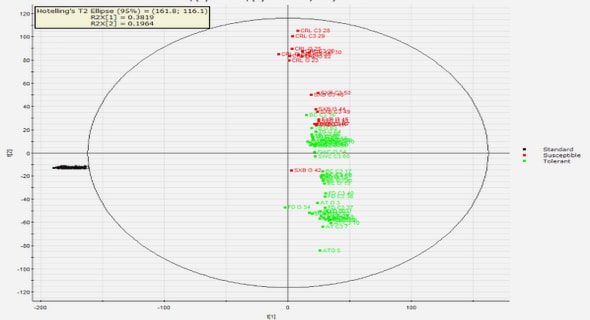Get Complete Project Material File(s) Now! »
CHAPTER 3 RESEARCH METHODOLOGY
Introduction
In this chapter, quantitative and qualitative research are briefly discussed and the rationale for choosing qualitative research for this study becomes evident. Approaches to selecting samples are outlined and purposive sampling described in detail, as it was the chosen method for selecting participants for this study. An overview of the methods of data collection used in qualitative research are discussed, although emphasis is placed on the semi-structured interview. The procedure of data analysis is clearly sketched out, and attention is given to ethical considerations.
Quantitative and qualitative research methods
Quantitative research methods
There are several ways of classifying research methods. However, in this chapter attention is given to quantitative and qualitative research methods. According to Maree and Pietersen (2014) and Struwig and Stead (2004) quantitative research is systematic and objective, and involves large representative samples of the population under study. It uses these samples to generalize the findings to entire populations. The primary role of quantitative research is to test hypotheses.
Maree and Pietersen (2014) described two main categories of quantitative research designs: experimental and non-experimental. Experimental designs have been developed to answer a specific kind of question ̶ the cause-and-effect question. It has three characteristics: 1) manipulation, where some of the participants receive some kind of treatment; 2) control, in which some participants are used as a control by not receiving the treatment; and 3) randomization, which is used to assign the participants to different groups (Maree & Pietersen, 2014).
In the experimental design all the participants are subjected to a pre-test and thereafter only the experimental group gets the treatment and then both groups do the post-test. The answer to whether the treatment was effective is obtained when comparing the scores of the post-test. Data usually come from a variety of sources and are captured on different scales with each one based on the amount of information or characteristics of the information in the data. The names of these four scales are: nominal, ordinal, interval and ratio. Nominal carries the least information, ordinal carries slightly more, the interval even more, and ratio carries the most information (Maree & Pietersen, 2014).
Non-experimental designs are mainly used in descriptive studies, in which the sample which has been selected to take part in the research is measured on all the relevant variables at a specific time. No manipulation takes place. The most widely used non-experimental research design is surveys (Maree & Pietersen, 2014).
Qualitative research methods
Qualitative research is a method of naturalistic enquiry which is usually less intrusive than quantitative methods and does not manipulate a research setting. This means that it aims to study people in their natural settings and to collect data as they occur. The research aims to understand the individual’s view, without making any value judgments during data collection. The focus is on the meaning that participants in the study attach to their social world (Bowling, 2014).
Hence, emphasis is placed on their lived experiences. This gives perspective to the meanings that people place on events, processes, structures of their lives, and their perceptions, assumptions, prejudgments and presuppositions. This highlights the importance of getting close to those we study, attempting to see the world through participants’ eyes, and conveying the experience in a way which is faithful to their everyday life (Ellis, 2004; Miles & Huberman, 1994).
Maree and Pietersen (2014) concluded that qualitative research methods are concerned with understanding the processes and the social and cultural contexts which influence certain behavioural patterns we observe in the participants we study. The research is mostly concerned with exploring the “why” questions. It aims to understand the meaning of human action and asks open-ended questions about phenomena as they occur in context rather than setting out to test predetermined hypotheses. Qualitative research is widely used in conducting psychological research (Carter & Little, 2007; Denzin & Lincoln, 2005).
Carter and Little (2007) wrote about analysing the qualitative data once it is gathered. They state that qualitative research means social research in which the researcher relies on text data rather than numerical data, and analyses the data in their textual form rather than converting it to numbers for analysis.
Ellis (2004) and Llewelyn and Kennedy (2003) further highlighted qualitative methods as being the more general and inclusive term. The term refers to a variety of research techniques and procedures. Approaches that could be considered qualitative include idiographic studies, ethnography, ethnomethodology, grounded theory, protocol analysis, discourse analysis, conversational analysis, constructivist approaches, humanistic approaches, phenomenology, hermeneutic investigation, conceptual studies, historical research, action research, and case study research (Maree & Pietersen, 2014; Stiles, 1993).
For the purpose of this study, case studies are used. The case studies incorporate ethnography, elements of auto-ethnography, and participatory action research.
Case study research
According to Hyette, Kenny and Dickson-Swift (2014) case study research is an increasingly popular approach among researchers. It is defined as an investigation and analysis of single or collective cases, which are intended to capture the complexity of the object of study. It is defined by interest in individual cases, rather than the methods of inquiry used.
Hyette et al. (2014) proposed three types of case study design frameworks: the intrinsic case study; the instrumental case study; and the collective instrumental case study. The intrinsic case study is used to understand the particulars of a single case, rather than what is represented. An instrumental case study provides insight on an issue or is used to refine theory; the case is selected to advance understanding of the object of interest. A collective case study refers to an instrumental case which is studied as multiple, nested cases, which are observed in union, parallel or sequential order. More than one case can be simultaneously studied; however, each case study is a concentrated, single enquiry, and is studied holistically in its own entirety.
Therefore, for the purposes of this study, the collective instrumental case study was chosen. The case studies are presented in chapters four to eight.
Simon (2009) emphasized that the primary purpose of a case study is to generate in-depth understanding of a specific topic as in a thesis. Bowling (2014) further elaborates and highlights that the number of case studies used is usually small as the cases are intensively explored in-depth, retrospectively, and sometimes over time, through for example, detailed observations, interviews, and by obtaining information from records.
A case study is flexible, is neither time-dependent nor constrained by methodology, and has the potential to involve participants in the research process. It also provides an opportunity for researchers to take a self-reflexive approach to understanding the case and themselves (Simon, 2009).
Subjective data is an integral part of the case. It is through analysis and interpretation of how people think, feel and act that many of the insights and understanding of the case are gained. A case study acknowledges that the researcher is the main instrument in data gathering, interpretation and reporting (Hyette et al., 2014). Hence, I collected all the data and then analysed all the data.
Stake in Simon (2009) in outlining his view of a case study indicates that he draws from naturalistic, holistic, ethnographic, phenomenological and biographic research methods. May (2011) stated that case study research resonates with participant observation and ethnographic traditions. Therefore, in this study, elements of ethnography, auto-ethnography and participatory action research are incorporated in the case studies, in an attempt to generate a comprehensive understanding of them. This corresponds to what Bowling (2014) suggested that multiple research methods can be employed to fully investigate complex situations and to validate the findings.
Ethnography
The word “ethnography” comes from two Greek words ethnos which means people and graphein which means to write, and implies writing about people (Maree & Pietersen, 2014). Genzuk (1999) and Pelto (2013) state that ethnography is the branch of anthropology that deals with a written, systematic description of a specific group or human culture.
Doing ethnography means using multiple methods of data collection like observation; interviews; collection of documents, pictures and audio-visual materials; and representations of artefacts. The main difference from other methods is that researchers do field work and collect their own data through their physical presence (Silverman, 2011).
Pelto (2013) further outlined and explained types of data collection that field researchers in ethnography undertake:
The central core of ethnographic data consists of written notes and perhaps some audio recordings of individual interviews, plus field notes from observations of events, actions, and related descriptive information.
A daily log of activities, which contains: (i) the amount of time spent on activities like interviews and direct observations and other brief notes about activities of the day; (ii) a personal diary of actions and thoughts related to field work including parts about planning, reviews of mistakes, emotional reactions to sensitive interviews, hunches and hypotheses about the field situation and the state of the data, and also other personal thoughts.
Collection of secondary materials, including newspaper accounts, newsletters, local writing, and organization records.
Structured survey forms, which are often a basic house-listing and demographic data set for describing the study of communities.
Photographs, videos, and other visual documentation.
Letters which field researchers write to families, colleagues, and friends, and which often have valuable syntheses of field information.
Conducting interviews and writing notes on my observations were the main methods of data collection in this study; in addition, photos were also taken.
Genzuk (1999) emphasized that ethnography relies on personal experience and possible participation, and not just observation. Ethnographers argue that it is necessary to learn the culture of the group being studied, before providing explanations of the behaviour of its members. Ethnography refers to social research that has most of the following features:
People’s behaviour is studied in an everyday context, rather than under experimental conditions created by the researcher.
Data are gathered from a range of sources but observation and/or relatively informal conversations are usually the main ones.
The approach to data collection is unstructured in the sense that it does not follow a detailed, pre-set plan.
The focus is usually on a single setting or group of a relatively small scale. The focus may even be on a single individual.
The analysis of data involves interpretation of the meanings and functions of human actions and mainly takes the form of verbal descriptions and explanations with quantification and statistical analysis mostly playing a subordinate role, at most.
Ethnographers, when writing an ethnography, try to capture a segment of time in the lives of those they are observing, and describe it in a way that allows others to understand what is happening (Berger, 2001). Denscombe (2010) states that another characteristic feature is the role of the researcher in the research process. The researcher’s identity, values and beliefs become submerged in the process and cannot be ignored, as they influence the findings. Ethnographic research therefore requires a degree of introspection.
Auto-ethnography
Auto-ethnography is understood as being the process by which researchers choose to make explicit use of their own involvement and experiences, as an integral part of ethnographic research (Butz & Besio, 2004). In auto-ethnography, the experiences of the researcher are important for the purpose of extending sociological understanding. Research starts with the researcher’s own experience as has been evident in the motivation for doing this particular study. In research that seeks to discover personal experience, there is a unique relationship between the researcher and the participants of the study, which cannot be ignored. It is suggested that the freedom of the researcher to voice his/her experiences as a contributor in the research process and merging their experiences with those of participants, is needed to promote inquiry and knowledge advancement. If the researcher’s experiences are overlooked, the writing is reduced to a summary and interpretation of others’ work with nothing new added (Wall, 2006). The use of auto-ethnography alongside other well-known qualitative research methods, is suggested (Wall, 2006). Hence, in this study it is used together with elements of ethnography, and participatory action research in the case studies.
According to Ellis (1999) in auto-ethnography the researcher might integrate parts of his/her experience into each participant’s story each of which can form a separate chapter. In each chapter, the researcher may reflect on different experiences they have had in each interview. This can be done by writing down their thoughts as they listen to the interview. The collaborative process allows readers to be more active participants in what they read, and also to witness the interaction between the researcher and the participant (Berger, 2001). In this study, this was achieved through reporting on my personal reflections and experiences, while conducting interviews and implementing interventions.
Auto-ethnography requires the reader to care, to feel, to empathize, and to do something. It needs the researcher to be vulnerable and intimate (Ellis & Brochner, 2006). In line with the above, it was crucial for me to congruently reflect on my own experiences during my interaction with all the participants, and also to report on the impact it had on me. This reflective process is described in detail in all the case studies.
CHAPTER 1 INTRODUCTION
1.1 Background information
1.2 What is Prader-Willi Syndrome?
1.3 Genetics and genomics of Prader-Willi Syndrome
1.4 How Prader-Willi Syndrome is diagnosed
1.5 Characteristics of individuals with Prader-Willi Syndrome
1.6 Mortality
1.7 Treatment and management of individuals with Prader-Willi Syndrome
1.8 Research problem and motivation
1.9 Objectives
1.10 Research approach
1.11 Research theory
1.12 Ethical considerations
1.13 Presentation
1.14 Conclusion
CHAPTER 2 LITERATURE REVIEW ON PRADER-WILLI SYNDROME
2.1 Introduction
2.2 Early development in PWS
2.3 Early childhood
2.4 Adolescence and adulthood
2.5 Diagnosis of PWS in adults
2.6 Perseveration
2.7 Eating behaviour and obesity
2.8 Growth hormone therapy (GHT)
2.9 Sleep problems
2.10 Speech and language disorders
2.11 Other medical illnesses
2.12 Self-injurious behaviour
2.13 Life expectancy
2.14 Education and social issues
2.15 Vocation training
2.16 The continuum of work placement options
2.17 Residential care for adults with PWS
2.18 Parental experiences and concerns from birth to adulthood
2.19 Behaviour Managemen
2.20 Inpatient crisis intervention for persons with PWS
2.21 Conclusion
CHAPTER 3 RESEARCH METHODOLOGY
3. 1 Introduction
3.2 Quantitative and qualitative research methods
3.3 Case study research
3.4 Ethnography
3.5 Auto-ethnography
3.6 Participatory action research
3.7 Participants and setting
3.8 Inclusion and exclusion criteria
3.9 Sampling
3.10.1 Documents
3.11 Procedure
3.12 Method of data analysis: Thematic analysis
3.13 Validity and reliability
3.14 Ethical considerations
3.15 Conclusion
CHAPTER 4 WILNA’S STORY: “ACCEPT THE WAY I AM”
4.1 Introduction
4.2 Family background
4.3 The context
4.4 Lived experiences
4.5 Interventions
4.6 Conclusion
CHAPTER 5 TSHEPISO’S STORY: “SHE IS NOT ABLE TO READ”
5.1 Introduction
5.2 Family background
5.3 The context
5.4 Lived experiences
5.5 Interventions
5.6 Conclusion
CHAPTER 6 KAMO’S STORY: “IT’S MY WEIGHT”
6.1 Introduction
6.2 Family background
6.3 The context
6.4 Lived experiences
6.5 Interventions
6.6 Conclusion
CHAPTER 7 REBA’S STORY: “BUT NOW I AM LEFT ALONE”
7.1 Introduction
7.2 Family background
7.3 The context
7.4 Lived experiences
7.5 Collateral and additional information
7.6 Interventions
7.7 Conclusion
CHAPTER 8 STEPHANIE’S STORY: “THAT’S ALL I WANT”
8.1 Introduction
8.2 Family background
8.3 The context
8.4 Lived experiences
8.5 Collateral information from class teachers
8.6 Interventions
8.7 Conclusion
CHAPTER 9 CONCLUSIONS, EVALUATIONS AND RECOMMENDATIONS
9. 1 Introduction
9.2 Research objectives and implementation thereof
9.3 A clinical description of PWS
9.4 The impact of PWS on the diagnosed individual
9.5 The impact of PWS on the primary caregiver
9.6 The impact of PWS on the school environment
9.7 Psychological insights
9.8 Personal reflections
9.9 Recommendations
9.10 Limitations and strengths of the research
9.11 Suggestions for future research
REFERENCES
GET THE COMPLETE PROJECT
THE DEVELOPMENT OF A THERAPEUTIC APPROACH FOR THE TREATMENT OF INDIVIDUALS WITH PRADER-WILLI SYNDROME AND THEIR PRIMARY CAREGIVERS


